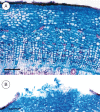Erythrina speciosa (Leguminosae-Papilionoideae) under soil water saturation: morphophysiological and growth responses
- PMID: 19581282
- PMCID: PMC2729630
- DOI: 10.1093/aob/mcp159
Erythrina speciosa (Leguminosae-Papilionoideae) under soil water saturation: morphophysiological and growth responses
Abstract
Background and aims: Erythrina speciosa is a Neotropical tree that grows mainly in moist habitats. To characterize the physiological, morphological and growth responses to soil water saturation, young plants of E. speciosa were subjected experimentally to soil flooding.
Methods: Flooding was imposed from 2 to 4 cm above the soil surface in water-filled tanks for 60 d. Non-flooded (control) plants were well watered, but never flooded. The net CO(2) exchange (A(CO2)), stomatal conductance (g(s)) and intercellular CO(2) concentration (C(i)) were assessed for 60 d. Soluble sugar and free amino acid concentrations and the proportion of free amino acids were determined at 0, 7, 10, 21, 28 and 45 d of treatments. After 28, 45 and 60 d, dry masses of leaves, stems and roots were determined. Stem and root cross-sections were viewed using light microscopy.
Key results: The A(CO2) and g(s) were severely reduced by flooding treatment, but only for the first 10 d. The soluble sugars and free amino acids increased until the tenth day but decreased subsequently. The content of asparagine in the roots showed a drastic decrease while those of alanine and gamma-aminobutyric increased sharply throughout the first 10 d after flooding. From the 20th day on, the flooded plants reached A(CO2) and g(s) values similar to those observed for non-flooded plants. These events were coupled with the development of lenticels, adventitious roots and aerenchyma tissue of honeycomb type. Flooding reduced the growth rate and altered carbon allocation. The biomass allocated to the stem was higher and the root mass ratio was lower for flooded plants when compared with non-flooded plants.
Conclusions: Erythrina speciosa showed 100 % survival until the 60th day of flooding and was able to recover its metabolism. The recovery during soil flooding seems to be associated with morphological alterations, such as development of hypertrophic lenticels, adventitious roots and aerenchyma tissue, and with the maintenance of neutral amino acids in roots under long-term exposure to root-zone O(2) deprivation.
Figures









Similar articles
-
Role of adventitious roots in water relations of tamarack (Larix laricina) seedlings exposed to flooding.BMC Plant Biol. 2012 Jun 27;12:99. doi: 10.1186/1471-2229-12-99. BMC Plant Biol. 2012. PMID: 22738296 Free PMC article.
-
Stem hypertrophic lenticels and secondary aerenchyma enable oxygen transport to roots of soybean in flooded soil.Ann Bot. 2010 Aug;106(2):277-84. doi: 10.1093/aob/mcq123. Ann Bot. 2010. PMID: 20660468 Free PMC article.
-
Root signals and stomatal closure in relation to photosynthesis, chlorophyll a fluorescence and adventitious rooting of flooded tomato plants.Ann Bot. 2009 Jan;103(2):313-23. doi: 10.1093/aob/mcn208. Epub 2008 Nov 10. Ann Bot. 2009. PMID: 19001430 Free PMC article.
-
Conditions leading to high CO2 (>5 kPa) in waterlogged-flooded soils and possible effects on root growth and metabolism.Ann Bot. 2006 Jul;98(1):9-32. doi: 10.1093/aob/mcl076. Epub 2006 Apr 27. Ann Bot. 2006. PMID: 16644893 Free PMC article. Review.
-
Interaction of flooding with carbon metabolism of forest trees.Plant Biol (Stuttg). 2004 May;6(3):299-306. doi: 10.1055/s-2004-817882. Plant Biol (Stuttg). 2004. PMID: 15143438 Review.
Cited by
-
Exogenous Application of GABA Improves PEG-Induced Drought Tolerance Positively Associated with GABA-Shunt, Polyamines, and Proline Metabolism in White Clover.Front Physiol. 2017 Dec 22;8:1107. doi: 10.3389/fphys.2017.01107. eCollection 2017. Front Physiol. 2017. PMID: 29312009 Free PMC article.
-
Effect of off-season flooding on growth, photosynthesis, carbohydrate partitioning, and nutrient uptake in Distylium chinense.PLoS One. 2014 Sep 15;9(9):e107636. doi: 10.1371/journal.pone.0107636. eCollection 2014. PLoS One. 2014. PMID: 25222006 Free PMC article.
-
Flood tolerance in two tree species that inhabit both the Amazonian floodplain and the dry Cerrado savanna of Brazil.AoB Plants. 2018 Oct 12;10(6):ply065. doi: 10.1093/aobpla/ply065. eCollection 2018 Dec. AoB Plants. 2018. PMID: 30455860 Free PMC article.
-
Physiological and comparative transcriptome analysis of the response and adaptation mechanism of the photosynthetic function of mulberry (Morus alba L.) leaves to flooding stress.Plant Signal Behav. 2022 Dec 31;17(1):2094619. doi: 10.1080/15592324.2022.2094619. Plant Signal Behav. 2022. PMID: 35786355 Free PMC article.
-
Hypoxia Affects Nitrogen Uptake and Distribution in Young Poplar (Populus × canescens) Trees.PLoS One. 2015 Aug 26;10(8):e0136579. doi: 10.1371/journal.pone.0136579. eCollection 2015. PLoS One. 2015. PMID: 26308462 Free PMC article.
References
-
- Andrade ACS, Ramos FN, Souza AF, Loureiro MB, Bastos R. Flooding effects in seedlings of Cytharexyllum myrianthum Cham. and Genipa americana L.: responses of two neotropical lowland tree species. Revista Brasileira de Botânica. 1999;22:281–285.
-
- Armstrong W, Brandle R, Jackson MB. Mechanisms of flood tolerance in plants. Acta Botanica Neerlandica. 1994;43:307–358.
-
- Bieleski RL, Turner NA. Separation and estimation of amino acids in crude plant extracts by thin-layer electrophoresis and chromatography. Analytical Biochemistry. 1966;17:278–293. - PubMed
-
- Cao FL, Conner WH. Selection of flood-tolerant Populus deltoides clones for reforestation projects in China. Forest Ecology and Management. 1999;117:211–220.

